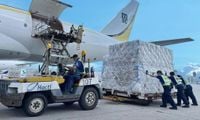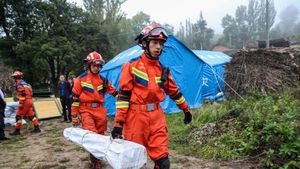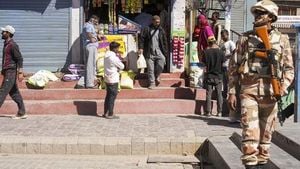Typhoon Ragasa, one of the fiercest storms to strike Asia in recent memory, left a trail of destruction across southern China, Taiwan, and the Philippines this week, while also grinding Hong Kong’s vital air cargo operations to a halt. As the typhoon battered coastal cities and upended lives, it became clear that its impact would be felt not only in the tragic loss of life and property but also in the disruption of global trade flows.
On September 24, 2025, Ragasa made landfall along the coast of Hailing Island in Yangjiang city, southern China, packing maximum winds near its center of 144 kph (89 mph), according to the Associated Press. A weather station in Chuandao town clocked gusts at a staggering 241 kph (about 150 mph)—a record for Jiangmen city since official records began. Nearly 1.9 million people were relocated across Guangdong province as authorities scrambled to protect residents from the storm’s fury.
In Hong Kong, the typhoon skirted just 100 kilometers (62 miles) to the south, bringing maximum sustained winds near the center of about 195 kph (120 mph). The city’s observatory categorized Ragasa as a super typhoon, a label reserved for cyclones with sustained winds of 185 kph or stronger. Hong Kong’s Observatory noted that Ragasa was the strongest tropical cyclone in the northwestern Pacific and South China Sea region so far this year, and, based on preliminary analysis, ranks as the second-strongest in the South China Sea since 1950, tying with Typhoons Saola in 2023 and Yagi in 2024.
The storm’s arrival was impossible to ignore. In the early hours, Hong Kong residents awoke to the sound of howling winds. Some took to social media to share scenes of chaos—a kitchen ventilation fan ripped from a wall, a swaying crane, and a vessel crashing into the shore, shattering glass railings along the waterfront. Hundreds of trees were toppled, and parts of a pedestrian bridge’s roof were blown away. Floodwaters surged across promenades, cycling lanes, and playgrounds. A viral video showed waves crashing through hotel doors, flooding the lobby. Restaurants along promenades found their furniture scattered chaotically by the storm. According to the Associated Press, 90 people were treated for injuries at hospitals.
Hong Kong and neighboring Macao, a major casino hub, canceled schools and flights as the typhoon approached. Many shops shuttered, and hundreds sought refuge in temporary shelters. Streets in Macao turned into streams, with debris floating on the water. Rescue crews deployed inflatable boats to reach those trapped by rising waters, and the local electricity supplier cut power to flooded, low-lying areas for safety. As winds eased, some residents waded into the streets to catch fish, a surreal scene in the storm’s aftermath.
The devastation was not confined to China. In Taiwan, 17 people died after heavy rains caused a barrier lake in Hualien County to overflow, submerging roads and sweeping away vehicles. In Guangfu township, with a population of about 8,450, more than half the residents sought safety on higher floors or higher ground. Emergency teams managed to contact over 100 previously unreachable residents in Hualien and were checking on the remaining 17. Across the island, 32 people were injured.
The northern Philippines also suffered. At least 10 deaths were reported, including seven fishermen who drowned when their boat was battered by huge waves and fierce wind off Santa Ana town in Cagayan province on September 22. Five other fishermen remained missing, and nearly 700,000 people were affected, with 25,000 fleeing to government emergency shelters.
As the winds howled and the rain fell, Hong Kong’s international airport—one of the world’s busiest air cargo hubs—ground to a standstill. According to The STAT Trade Times, the airport suspended flights for about 36 hours, beginning September 23, as Ragasa’s winds made operations unsafe. Partial service resumed on the evening of September 24, with the first reported landing in nearly a day being a China Airlines Cargo Boeing 777 freighter.
On September 25, the airport officially reopened, operating all three runways and activating its Airport Emergency Centre. However, strong gusts and crosswinds meant that passenger flights would not resume before midnight. The Airport Authority Hong Kong (AAHK) implemented the Flight Rescheduling Control System (FRCS) to manage the post-storm recovery, requiring airlines to submit slot requests for departures. Cathay Pacific, the city’s flagship carrier, cancelled multiple long-haul flights on September 23, including departures to Zurich, Los Angeles, and New York–JFK. By September 25, Cathay Pacific reported that all long-haul passenger flights from the Americas, Europe, and Australia had arrived safely and were being prepared for same-day departures, though the airline cautioned that a full recovery would take time.
The disruption to cargo operations was immense. Tim van Leeuwen, Vice President and Head of Consulting at Rotate, a cargo and capacity tracking platform, estimated that Typhoon Ragasa affected around 26,000 tonnes of air cargo at Hong Kong International Airport—equivalent to about 160 Boeing 777 freighters. The resulting backlogs and schedule adjustments rippled through global logistics networks. Rotate’s Live Capacity data showed outbound cargo capacity dropping from nearly 12,000 tonnes on September 21 to just 7,000 tonnes on September 23, and bottoming out at about 2,000 tonnes by September 24. Remarkably, capacity rebounded above 12,000 tonnes by September 25 as operations resumed.
Wilson Kwong, Chief Executive of Hong Kong Air Cargo Terminals Limited (Hactl), told The STAT Trade Times that the company was bracing for a busy period ahead of the typhoon and actively planning the recovery process. By September 26, Hactl’s cargo terminal was bustling as the airport prioritized passenger flights on September 25 before ramping up cargo operations.
The effects of Ragasa extended beyond air logistics. Freightos, a digital freight platform, reported that disruptions to ocean logistics caused by the storm could prompt a short-term shift to air cargo. On September 25, the Freightos Air Index showed weekly rate increases on key trade lanes: China to North America rose 4% to $5.44/kg, China to Northern Europe increased 2% to $3.72/kg, and Northern Europe to North America went up 3% to $1.77/kg.
As the clean-up continues and the region assesses the full extent of the damage, Ragasa’s legacy will be measured not just in the shattered infrastructure and tragic loss of life, but also in the resilience of communities and the adaptability of global trade. The storm’s passage serves as a stark reminder of nature’s power—and the interconnectedness of economies and lives across Asia and beyond.




